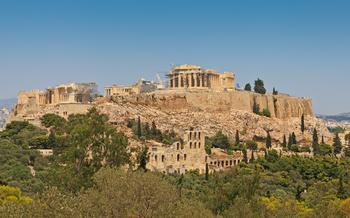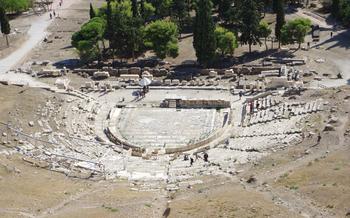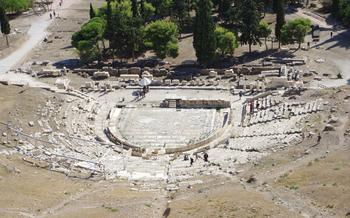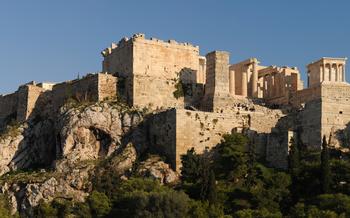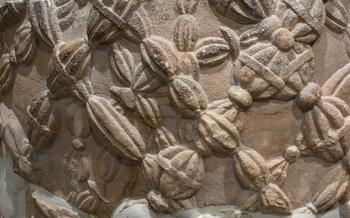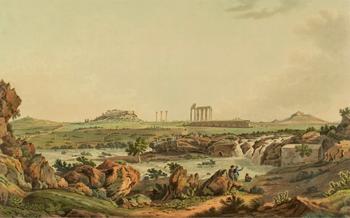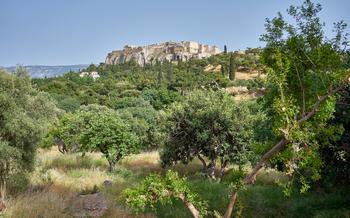
Choragic Monument of Lysicrates
- The Choragic Monument of Lysicrates: A Timeless Masterpiece
- Location and Accessibility
- History and Background
- Architectural Highlights
- Significance in Ancient Greek Theater
- Visiting the Monument Today
- Tips for Enhancing Your Visit
- Historical Context of Ancient Greek Theater
- The Role of the Chorus in Ancient Greek Theater
- Architectural Features and Symbolism
- The Choragic Monument of Lysicrates as a Cultural Landmark
- Experiencing the Ancient Greek Theater Today
- Top Tips for Photography Enthusiasts
- Uncovering Hidden Gems Nearby
- Insider Tip: Unveiling a Secret Spot
The Choragic Monument of Lysicrates: A Timeless Masterpiece
Amidst the vibrant tapestry of ancient Athenian history, the Choragic Monument of Lysicrates stands as a testament to the city's enduring devotion to the arts. Erected around 334 BC, this exquisitely preserved monument is a testament to the architectural prowess and cultural significance of ancient Greece. Commissioned by the wealthy patron Lysicrates to commemorate his victory in a theatrical competition, the monument served as a symbol of appreciation for artistic achievements and a reminder of the city's rich theatrical heritage.
As you approach the monument, its intricate Corinthian columns and sculpted frieze depicting the myth of Dionysus and the pirates immediately captivate the eye. The monument's architectural style, a blend of classical and Hellenistic elements, showcases the transition from the austere simplicity of the Doric order to the more ornate and elaborate aesthetic of the Corinthian style.
The Choragic Monument of Lysicrates is not merely a relic of the past but also a living testament to the enduring power of the arts. It stands as a reminder of the importance ancient Athenians placed on creativity, artistic expression, and the celebration of human achievements.
Location and Accessibility
The Choragic Monument of Lysicrates is conveniently situated in the heart of Athens, at the foot of the Acropolis, on a small street named Tripodon. To reach this historical gem, visitors can take advantage of the city's well-connected public transportation system. The nearest metro station is Akropoli, from where a short walk along Dionysiou Areopagitou Street leads directly to the monument. Alternatively, a pleasant stroll from the lively Plaka neighborhood, known for its charming streets and shops, takes approximately 15 minutes. The monument is easily accessible on foot, making it an ideal destination for those exploring the historic center of Athens.
History and Background
The Choragic Monument of Lysicrates stands as a testament to the vibrant cultural heritage of ancient Athens. The city, renowned as a cradle of democracy and intellectual pursuits, nurtured a thriving theater tradition that celebrated the arts and honored the achievements of talented individuals. Choragic dedications, a unique feature of ancient Greek theater, were erected by wealthy patrons to commemorate their victories in dramatic competitions. These monuments served as tangible symbols of civic pride and gratitude, recognizing the contributions of artists, playwrights, and actors to the cultural fabric of Athens.
One such patron was Lysicrates, a wealthy Athenian who sponsored a chorus that won first prize in the dithyramb competition during the Dionysia festival in 335 BC. To mark this prestigious victory, Lysicrates commissioned the construction of the Choragic Monument that bears his name. The monument's architectural style reflects the prevailing trends of the Hellenistic period, characterized by intricate details and a fusion of classical and oriental elements.
Architectural Highlights
At the heart of the Choragic Monument of Lysicrates lies its intricate Corinthian columns. These stately columns, with their distinctive acanthus leaf capitals, exemplify the elegance and refinement of the Corinthian order. The acanthus leaves, arranged in two rows, seem to dance upwards, creating a sense of movement and vitality.
The frieze that encircles the monument is a masterpiece of Hellenistic sculpture. It depicts the myth of Dionysus and the pirates, a tale of transformation and divine retribution. The story unfolds in a continuous narrative, with Dionysus, the god of wine and revelry, at its center. Surrounded by his entourage of satyrs and maenads, Dionysus is shown subduing a group of pirates who attempted to kidnap him. The pirates, transformed into dolphins, swim beneath the ship, symbolizing their defeat and Dionysus' triumph.
Atop the monument, three acroteria stand as silent witnesses to the monument's dedication. These decorative elements, often overlooked by visitors, hold significant symbolic meaning. The central acroterion features a tripod, a symbol of Apollo, the god of music and the arts. Flanking the tripod are two sirens, mythical creatures known for their enchanting voices. The sirens represent the power of music and its ability to captivate and transport the listener.
Finally, an inscription encircles the base of the monument, providing valuable information about its history and purpose. The inscription, written in ancient Greek, reveals that the monument was dedicated to Dionysus by Lysicrates, a wealthy patron of the arts, in gratitude for his victory in a dramatic competition. The inscription serves as a testament to the importance of theater in ancient Athens and the role of wealthy individuals in supporting the arts.
Significance in Ancient Greek Theater
The Choragic Monument of Lysicrates holds immense significance in the context of ancient Greek theater. During the annual Dionysia festival, dedicated to the god Dionysus, wealthy patrons like Lysicrates would sponsor theatrical productions and compete for recognition. These competitions were a vital part of Athenian culture, showcasing the city's artistic prowess and civic pride.
Theater Competitions and Civic Pride
Theater competitions in ancient Athens were fiercely contested, with playwrights, actors, and choruses vying for the prestigious honor of victory. The choragic monument served as a physical representation of this competition, acknowledging the achievements of successful patrons and their contributions to the cultural landscape of the city.
Recognizing Artistic Excellence
Winning a theater competition brought immense prestige and recognition to the patron, who would be celebrated for their generosity and support of the arts. The choragic monument served as a lasting testament to their patronage, ensuring that their contributions would be remembered for generations to come.
Patronage and Cultural Achievements
Wealthy patrons like Lysicrates played a crucial role in supporting and promoting the arts in ancient Athens. Their financial contributions enabled the production of elaborate theatrical performances, which were enjoyed by citizens from all walks of life. These patrons were celebrated for their civic pride and their commitment to preserving and enhancing Athenian culture.
The Choragic Monument of Lysicrates stands as a testament to the vibrant theater culture of ancient Athens, honoring the achievements of both playwrights and patrons who contributed to the city's rich artistic heritage.
Visiting the Monument Today
The Choragic Monument of Lysicrates stands as a testament to ancient Athenian artistry and cultural achievements. To fully appreciate its grandeur, plan your visit during its opening hours, which typically run from morning until late afternoon. Admission to the monument is free, allowing visitors to explore this architectural marvel without any financial constraints. Guided tours are available for those seeking a deeper understanding of the monument's history and significance. These tours provide insightful commentary and anecdotes that bring the monument to life. While photography is generally permitted, it is essential to be respectful of other visitors and the monument's preservation. By adhering to these guidelines, you can fully immerse yourself in the beauty and historical significance of the Choragic Monument of Lysicrates.
Tips for Enhancing Your Visit
To make the most of your visit to the Choragic Monument of Lysicrates, consider the following recommendations:
-
Best time to visit: Aim for early morning or late afternoon to avoid the harsh midday sun and crowds. The monument's intricate details and carvings are best appreciated in soft, natural light.
-
Combining with other attractions: The monument is conveniently located near several other significant landmarks. Combine your visit with a stroll through the picturesque Anafiotika neighborhood, a climb to the top of Philopappos Hill for panoramic city views, or a visit to the Dionysus Sanctuary, where ancient Athenians celebrated the god of theater.
-
Exploring the neighborhood: Take some time to explore the surrounding Plaka neighborhood, the oldest district in Athens. Wander through its narrow, winding streets, lined with charming shops, traditional tavernas, and hidden courtyards, offering a glimpse into the city's rich history and vibrant culture.
-
Local cuisine: Indulge in authentic Greek cuisine at one of the many tavernas or restaurants near the monument. Savor traditional dishes such as moussaka, souvlaki, or fresh seafood, complemented by a glass of local wine or refreshing ouzo.
Historical Context of Ancient Greek Theater
The origins of ancient Greek theater can be traced back to religious rituals and festivals honoring Dionysus, the god of wine and revelry. Over time, these rituals evolved into dramatic performances that explored various themes, including mythology, politics, and social issues. Ancient Greek theater encompassed three main genres: tragedy, comedy, and satyr plays.
Tragedy, the most prominent genre, delved into serious themes such as human suffering, fate, and the consequences of hubris. Notable tragedians included Sophocles, whose works like "Oedipus Rex" and "Antigone" are still widely studied and performed today.
Comedy, on the other hand, offered a lighter perspective, satirizing contemporary society and poking fun at human follies. Aristophanes was a renowned comic playwright whose works, such as "The Clouds" and "The Birds," criticized political figures and social norms.
Satyr plays, a unique form of drama, combined elements of tragedy and comedy with a chorus of satyrs, mythical half-human, half-goat creatures. These plays often featured mythological themes and served as a comedic interlude between tragedies.
Ancient Greek theater not only entertained but also served as a platform for social commentary and philosophical exploration, reflecting the intellectual and cultural vitality of Athenian society.
The Role of the Chorus in Ancient Greek Theater
In ancient Greek theater, the chorus played a crucial role, serving as a collective voice that provided commentary, reflection, and insights on the themes and actions of the play. Composed of a group of actors, typically between 12 and 15 members, the chorus stood on stage throughout the performance, often dressed in elaborate costumes and masks.
The chorus functioned as a unifier, connecting the audience with the events unfolding on stage. Through their spoken and sung lines, the chorus commented on the characters' actions, expressed emotions and reactions to the plot, and offered moral reflections or philosophical insights. They served as a collective voice of the community, representing the thoughts and feelings of the Athenian citizens.
Moreover, the chorus acted as a bridge between the human world and the divine realm. They often invoked the gods, appealed for their intervention, or sang hymns in their honor. By doing so, the chorus helped to create a sense of awe and reverence, reminding the audience of the presence of the divine in human affairs.
Beyond their commentary and reflections, the chorus also played a crucial role in the development of the plot. They interacted with the main characters, providing advice, warnings, or encouragement. At times, the chorus even participated directly in the action, becoming active participants in the story.
Through their collective voice, the chorus provided a unique perspective that enriched the theatrical experience for ancient Greek audiences. They added depth and complexity to the plays, inviting spectators to contemplate the moral, ethical, and philosophical dimensions of the human condition.
Architectural Features and Symbolism
The Choragic Monument of Lysicrates stands as a testament to the architectural prowess and symbolic significance of ancient Greece. Its Corinthian columns, intricately carved frieze, and decorative acroteria each hold layers of meaning and symbolism.
The Corinthian columns, with their acanthus leaf-adorned capitals, represent a fusion of elegance and strength. They symbolize the monument's dedication to Dionysus, the god of wine and revelry, whose association with nature is reflected in the organic motifs of the columns.
The frieze, encircling the monument, depicts the myth of Dionysus and the pirates. In this tale, Dionysus transforms the marauding sailors into dolphins, symbolizing his power over the sea and his ability to protect his followers. The frieze serves as a reminder of Dionysus' divine intervention and his role as a protector of travelers and sailors.
The acroteria, positioned atop the monument, are adorned with intricate sculptures. Each acroteria tells a story, such as the abduction of the nymph Europa by Zeus, disguised as a bull. These decorative elements not only enhance the monument's visual appeal but also add layers of mythological symbolism, enriching the monument's narrative.
An ancient Greek inscription encircles the base of the monument, providing valuable information about its dedication and purpose. The inscription reveals that the monument was erected by Lysicrates, a wealthy patron of the arts, to commemorate his victory in a dramatic competition during the Dionysia festival. This inscription serves as a testament to the importance of theater and the arts in ancient Athenian society.
The Choragic Monument of Lysicrates as a Cultural Landmark
The Choragic Monument of Lysicrates stands as a testament to the enduring legacy of ancient Greek culture and artistic achievement. Recognized as a UNESCO World Heritage Site, this monument is not merely a relic of the past but a living symbol of the deep appreciation and recognition that ancient Athenians held for artistic excellence.
The monument's status as a cultural landmark is not simply a matter of its historical significance but also of its enduring influence on modern architecture and design. Its unique Corinthian columns, intricate frieze, and symbolic acroteria have inspired countless artists, architects, and designers throughout history, leaving an indelible mark on the development of Western art and architecture.
Beyond its aesthetic and architectural significance, the Choragic Monument of Lysicrates holds cultural significance as a symbol of the vibrancy and creativity that characterized ancient Greek society. It is a reminder of the importance that the ancient Athenians placed on the arts, particularly theater, and their willingness to celebrate and honor artistic achievements.
Preservation and conservation efforts have ensured that this remarkable monument continues to stand as a source of inspiration and wonder for generations to come. The monument's enduring legacy serves as a reminder of the enduring power of art and culture to transcend time and continue to captivate and inspire people from all walks of life.
Experiencing the Ancient Greek Theater Today
The legacy of ancient Greek theater extends far beyond the confines of the Choragic Monument of Lysicrates. Modern adaptations and performances of ancient Greek plays allow audiences to experience the power and artistry of these timeless works. Festivals such as the Athens Epidaurus Festival and the International Festival of Ancient Greek Drama bring these plays to life in stunning outdoor settings, including the ancient theaters of Epidaurus and Dionysus.
For a deeper dive into the world of ancient Greek theater, consider visiting the National Archaeological Museum in Athens. This world-renowned museum houses an extensive collection of artifacts related to theater, including masks, costumes, and sculptures. Educational programs, workshops, and reenactments offered by the museum provide a unique opportunity to learn about the history, practices, and cultural significance of ancient Greek theater.
Venturing beyond Athens, one can discover other well-preserved ancient theaters that offer a glimpse into the grandeur of theatrical performances in the ancient world. The Epidaurus Theater, located in the Peloponnese region, is considered one of the finest examples of ancient Greek theater architecture, renowned for its exceptional acoustics and stunning setting. The Theater of Dionysus in Athens, where the great tragedies and comedies of Sophocles, Euripides, and Aristophanes were first performed, is another must-see for theater enthusiasts.
By experiencing ancient Greek theater through modern performances, visiting museums, and exploring ancient theaters, one can gain a deeper appreciation for the enduring legacy of this remarkable art form.
Top Tips for Photography Enthusiasts
For photography enthusiasts, the Choragic Monument of Lysicrates presents a unique opportunity to capture stunning images of this ancient architectural marvel. To make the most of your photography experience, here are some expert tips:
-
Capture the best angles: Experiment with different angles to find the most flattering perspective. The monument looks particularly impressive when photographed from a low angle, highlighting its grandeur.
-
Consider lighting conditions: The best time to photograph the monument is during the golden hours, just after sunrise or just before sunset. The warm, diffused light during these times will enhance the monument's intricate details and create a magical atmosphere.
-
Use a tripod and compose carefully: A tripod is essential for ensuring sharp and steady shots, especially in low-light conditions. Take your time to compose your shot, paying attention to the monument's position within the frame and the surrounding elements.
-
Experiment with different lenses: Different lenses can create different effects. A wide-angle lens can capture the monument's full grandeur, while a telephoto lens can isolate specific details and create a more intimate feel.
Uncovering Hidden Gems Nearby
Beyond the Choragic Monument of Lysicrates, the surrounding area offers a treasure trove of hidden gems waiting to be discovered. One such gem is the picturesque neighborhood of Anafiotika, nestled on the slopes of the Acropolis. With its charming whitewashed houses adorned with colorful flowers and narrow cobblestone streets, Anafiotika exudes a unique Cycladic charm, transporting visitors to a serene island escape amidst the bustling city.
For breathtaking panoramic views of Athens and the surrounding landscape, a visit to Philopappos Hill is a must. This verdant hilltop park is home to the ancient Monument of Philopappos, a grand tomb dedicated to a Roman consul. As you ascend the hill, you'll be rewarded with stunning vistas that encompass the Choragic Monument of Lysicrates, the Acropolis, and the sprawling cityscape stretching out to the horizon.
To delve deeper into the ancient world, a short walk from the monument will lead you to the Dionysus Sanctuary, a sacred site dedicated to the god of wine and theater. This atmospheric sanctuary once hosted grand celebrations and theater performances in honor of Dionysus. Explore the well-preserved ruins of the theater, the Temple of Dionysus, and the surrounding stoa, and let your imagination transport you back to the days of ancient Athenian revelry.
For a touch of modern entertainment, the Museum of Illusions, located just a stone's throw from the monument, offers a fun and interactive experience for visitors of all ages. Step into a world of optical illusions, mind-bending puzzles, and immersive exhibits that will challenge your perception and leave you questioning the nature of reality.
Insider Tip: Unveiling a Secret Spot
Beyond the Choragic Monument of Lysicrates lies a hidden gem waiting to be discovered. Tucked away amidst the ancient ruins, a secret viewpoint offers breathtaking panoramas of the Acropolis and the sprawling cityscape of Athens. To reach this hidden treasure, follow the path behind the monument and ascend the gentle slope. Along the way, admire the ancient ruins and soak in the tranquility of this secluded spot.
Once you reach the viewpoint, prepare to be mesmerized by the stunning vistas that unfold before you. The Acropolis, with its iconic Parthenon, dominates the skyline, while the city of Athens stretches out in all its glory, a tapestry of ancient and modern wonders. Capture the moment with your camera, as the golden hues of sunset bathe the cityscape in a warm glow.
This hidden viewpoint is the perfect place to escape the hustle and bustle of the city and immerse yourself in the timeless beauty of Athens. Whether you're a seasoned traveler, a history buff, or simply someone seeking a unique and unforgettable experience, this secret spot is sure to leave you spellbound.
